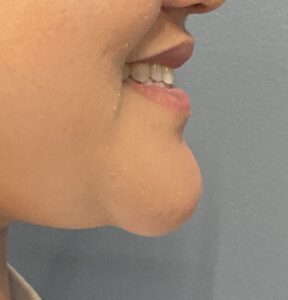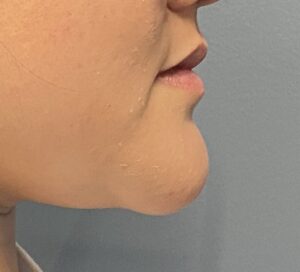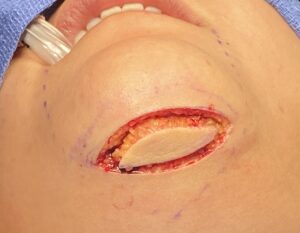Background: The large chin (macrogenia) can be caused by excessive bone, soft tissue or both. A unique form of congenital macrogenia, most commonly seen in females, is a pure soft tissue excess known as chin pad hypertyrophy. Often called a fleshy chin the size of the overlying soft tissue is disproportionately larger than that of the underlying bone. As a result of its size the chin pad is very mobile both manually and in animation. In smiling the chin pad pulls downward creating an almost witch’s chin deformity. The chin elongates and a deepened submental crease develops. (hyperdynamic chin pad ptosis)
While the fleshy chin is composed of excessive soft tissue it is definitely not improvable but liposuction. Trying to suction fat from the chin is a failure to understand the soft tissue anatomy of the chin as well as how it responds to soft tissue deflation. While there is fat in the chin it is very fibrous in nature and is intermingled with muscle fibers. Thus not much fat is going to be removed but considerable trauma will occur to the mentalis muscle. This will often result in postoperative fasiculations of muscle movement seen as surface irregularities. In addition scar contraction of the chin will result in a balled-up effect since it is a 3D shrinkage over a projecting point. In essence not only will the chin not get any smaller but it will likely end looking worse.
The correct treatment for the fleshy chin is submental excision. Full thickness tissue removal is needed (skin, fat and muscle) to reduce the soft tissue volume. Since this is done on the underside of the chin closure of the excision results in a tightening tuck. While this does create a scar on the underside of the chin it is easy to see why a soft tissue excess is more effectively reduced by a technique that has a greater soft tissue removal effect.



While liposuction may work for other body areas of soft tissue excess it it snot going to work in the chin. The fat in the chin makes up a small part of the excess and is not amenable to liposuction extraction. The skin of the chin also has little ability to shrine down since it is a 3D projecting prominence. Only cutting out the excess is effective and the submental location is the only place to put such an decisional scar.
Case Highlights:
1) The large chin which is a result of too much soft tissue chin pad can not be reduced by liposuction…and will actually make it worse.
2) Soft tissue chin pad excess is a frequent cause of hyper dynamic chin ptosis.
3) Chin pad excess can only be effectively reduced by a submental excisional technique. (submental chin reduction)
Dr. Barry Eppley
World-Renowned Plastic Surgeon






